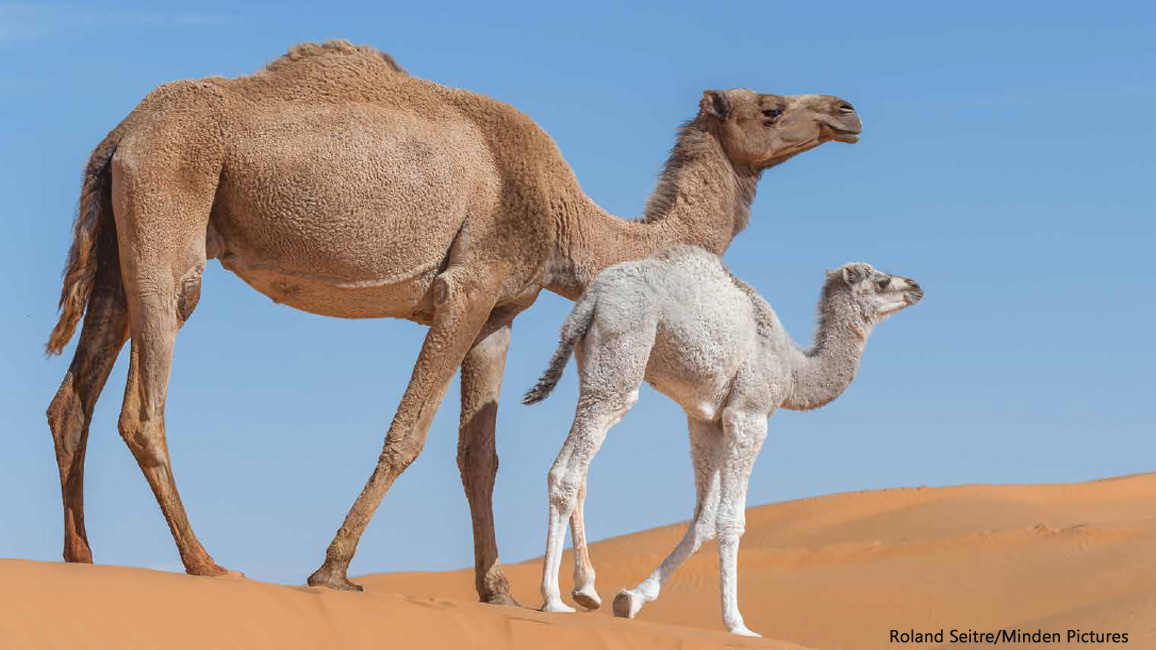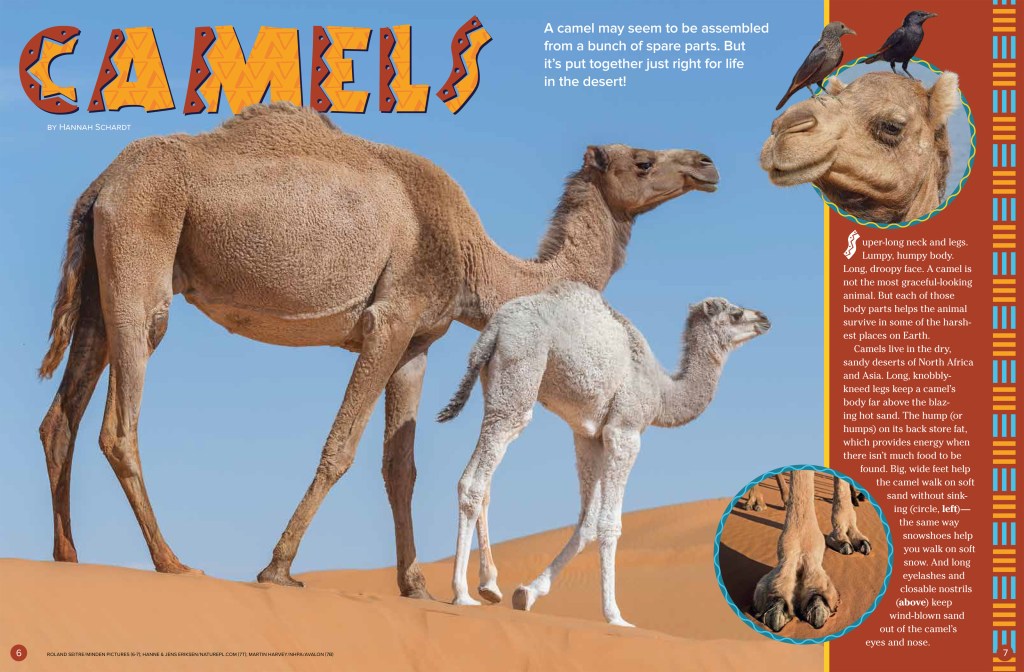
Camels
By Hannah SchardtA camel may seem to be assembled from a bunch of spare parts. But it’s put together just right for life in the desert!

Super-long neck and legs. Lumpy, humpy body. Long, droopy face. A camel is not the most graceful-looking animal. But each of those body parts helps the animal survive in some of the harshest places on Earth.
Camels live in the dry, sandy deserts of North Africa and Asia. Long, knobbly-kneed legs keep a camel’s body far above the blazing hot sand. The hump (or humps) on its back store fat, which provides energy when there isn’t much food to be found. Big, wide feet help the camel walk on soft sand without sinking—the same way snowshoes help you walk on soft snow. And long eyelashes and closable nostrils keep wind-blown sand out of the camel’s eyes and nose.

ONE HUMP OR TWO?
There are two types of camels. You can tell them apart by counting their humps. If a camel has one hump, it’s a dromedary (DRAH-muh-dair-ee). If it has two, it’s a Bactrian (BAK-tree-un) camel. Dromedaries live mostly in North Africa and the Middle East. Bactrian camels live mostly in Central Asia’s Gobi Desert.
The Gobi can be bitterly cold. So the Bactrian camel grows a long, thick coat each winter. And while both camels are big, the bulky Bactrian is much heavier than its cousin. It can weigh as much as a ton!
DRINK UP
Water can be hard to come by in a desert. So when a camel has a chance to drink, it may guzzle down as much as 50 gallons of water in a few minutes. That’s enough to fill a good-sized kiddie pool!
You may have heard that camels store water in their humps. That isn’t true. But camels are great at saving the water they drink. They don’t sweat much. And they lose very little water when they pee, so their urine may be as thick as syrup.
CAMEL KEEPERS
A strong, sturdy camel can carry several hundred pounds on its back. So before there were planes, trains, or trucks, many people relied on camels to move people and cargo. Some still do!
These days, there are hardly any wild camels left. In fact, there are no wild dromedaries at all. A few thousand wild Bactrian camels live in parts of Asia. But millions of camels still live and work with people.

CAMEL COUSINS
If you used a shrink ray on a camel, you might get something that looked like a guanaco (gwuh-NAH-koh) or a vicuña (vih-KOON-yah). These wild camel relatives live in parts of South America.
While a camel may be seven feet tall at its hump, guanacos and vicuñas are probably shorter than you—only three or four feet tall. The bottoms of their feet are soft and squishy, which helps them scramble up and down rocky mountainsides. And they have no need for fat-storing humps. They find plenty of grasses and other plants to eat in the mountains and plains where they live.
Vicuñas and guanacos live in herds. A herd is usually made up of one male, several females, and their babies, called crias (KREE-ahs).
Once, people hunted too many guanacos and vicuñas for their meat and woolly pelts. But now they’re protected by laws in many of the places where they live.
ON THE JOB
Thousands of years ago, people started breeding some guanacos to be pack animals. Today, the domestic cousins of those guanacos are called llamas (LAH-muhz or YAH-mahs). Vicuñas’ domestic cousins are called alpacas (al-PAK-uhz). They were bred to have lots of soft, fast-growing fiber (wool). In South America, millions of llamas and alpacas now live on farms or in people’s yards.
Llamas and alpacas are very useful to the people they live with. Alpaca fiber can be sold or made into clothes and blankets. Llamas carry goods to sell at a market over miles of rocky, steep terrain. And llama poop can even be dried and burned for fuel. Thanks, camel family!
















